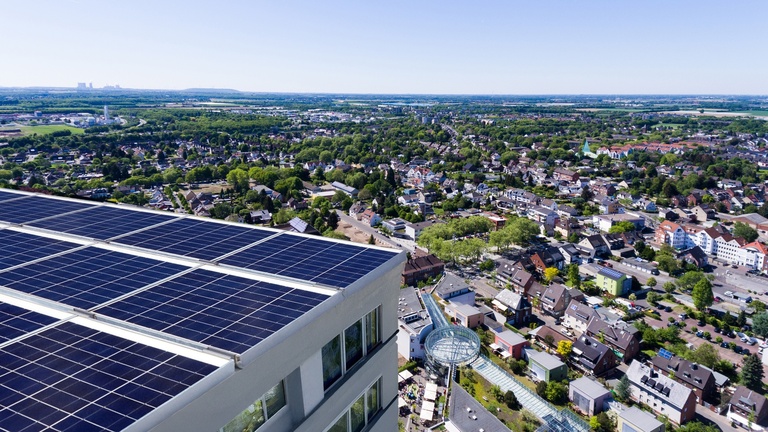Dormagen, Germany, November 20, 2025. By 2030, at least 80 percent of German electricity is to come from renewable energy. Dormagen, a city located in the German federal state of North Rhine-Westphalia, aims to make its own contribution by expanding photovoltaic use at a faster pace. To leverage the solar potential on its municipal properties, the town commissioned Drees & Sommer to develop a photovoltaic (PV) master plan. The Stuttgart-based company specializes in construction, real estate and infrastructure consulting. Drees & Sommer’s team of experts is developing an overall plan for around 90 properties with 180 buildings, including the collection and registration of all relevant data, a technical potential analysis, a feasibility study, and a strategic prioritization matrix for the assessed real estate. All the results of the work will be available in 2026.
Schools, community centers, city and town halls: in Germany, public buildings have enormous capacity for photovoltaics that often remains unused. According to a study, only 1.1 percent of all solar panels have been installed on public buildings.1 “Dormagen’s roofs ,too, offer ample space for photovoltaic systems. The PV master plan is consequently a logical step towards making our municipal properties fit for the future and achieving the city's climate action goals,“ emphasizes Dr. Martin Brans, Dormagen’s councilor responsible for public works.
The town of 65,000 inhabitants in the Rhine district of Neuss has been driving forward climate action and the expansion of renewable energy for years. It was only in the summer of 2025 that Dormagen received funding of 330,000 euros for photovoltaic systems on municipal roofs. It plans to install them on a sports facility in the village of Zons, the public library and two schools. The photovoltaic master plan is to indicate additional solar potential and further ways of achieving the objectives.
From Fire Protection to Green Roofs – Taking an All-Round View
Drees & Sommer’s project head Yuri Leon-Dvoryaninov explains the project work: “The analysis goes beyond assessing technical feasibility. In addition to factors such as structural stability, electrical infrastructure, fire protection and the preservation of historic buildings, we also assess the combination of photovoltaics with extensive and intensive roof greening.“ The team of experts also takes into account funding programs, economic targets and the requirements of the EU Energy Performance of Buildings Directive (EPBD) aimed at improving the energy efficiency of buildings.
“Our task is to develop a clearly defined and economically viable implantation strategy for the city. In addition to reliable data on the size of systems and investment costs, the analysis will provide information about potential operator models and amortization times,“ the expert adds.
Yuri Leon-Dvoryaninov explains that the comprehensive strategy also takes account of PV systems in operation and buildings on which PV arrays are planned to be deployed. Following an in-depth study of the available material, onsite visits and an analysis of eligible roof surfaces have started.
More Solar Electricity, Lower Operating Costs
In Germany, energy costs account for around 30 percent of the total operating costs of municipality-owned buildings,2 accompanied by high carbon dioxide emissions. This means that photovoltaic systems on public buildings, especially those with high levels of consumption during daytime, such as schools and sports halls, also make economic sense. Dr. Martin Brans says: “In the long term, the PV master plan will not only benefit municipal properties, which primarily use the generated electricity for their own needs and thus reduce their operating costs.” As the councilor explains, the surplus electricity is fed into the public power grid, thus the city's residents also benefit from it at a later stage. Overall, the city administration estimates the solar PV potential on Dormagen's (public and private) roofs at around 225,000 megawatt hours (MWh) per year.
The overall results of the photovoltaic master plan are expected to be available in 2026. They provide the basis for the administrative bodies’ decision-making process regarding investments in PV systems. In addition to general feasibility, Drees & Sommer’s specialists are also examining storage solutions and tenant electricity models within the scope of the contract. As in some other German federal states, North Rhine-Westphalia has required all new non-residential buildings to be fitted with solar panels since 2024. In July of last year, this was extended to fundamental roof renovations on municipal buildings and those owned by the federal state.
Sources (available in German only):
1: Viessmann Climate Solutions: Erneuerbare Energien im öffentlichen Sektor (‘renewable energies in the public sector’)
2: Kom.EMS Leitfaden: Energiemanagement in Kommunen. Eine Praxishilfe, S. 60 (‘guideline for municipal energy management systems: energy management at the municipal level; a practice guide, p. 60)
